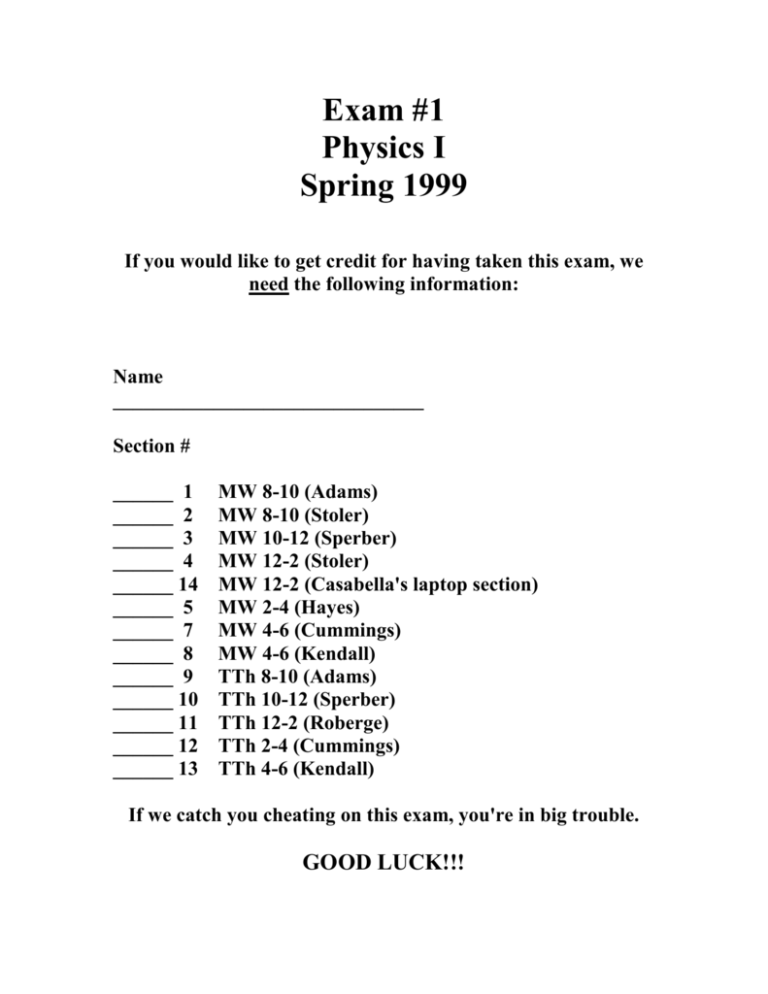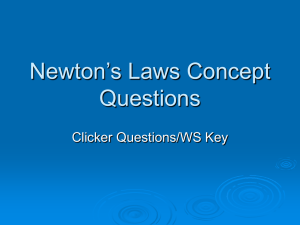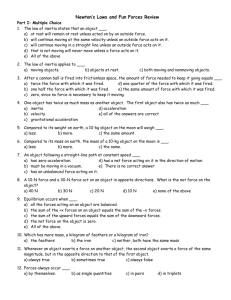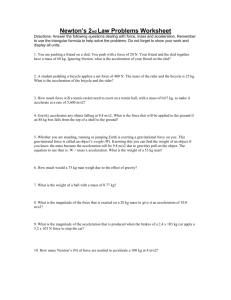Quiz1-S99
advertisement

Exam #1 Physics I Spring 1999 If you would like to get credit for having taken this exam, we need the following information: Name _______________________________ Section # ______ 1 ______ 2 ______ 3 ______ 4 ______ 14 ______ 5 ______ 7 ______ 8 ______ 9 ______ 10 ______ 11 ______ 12 ______ 13 MW 8-10 (Adams) MW 8-10 (Stoler) MW 10-12 (Sperber) MW 12-2 (Stoler) MW 12-2 (Casabella's laptop section) MW 2-4 (Hayes) MW 4-6 (Cummings) MW 4-6 (Kendall) TTh 8-10 (Adams) TTh 10-12 (Sperber) TTh 12-2 (Roberge) TTh 2-4 (Cummings) TTh 4-6 (Kendall) If we catch you cheating on this exam, you're in big trouble. GOOD LUCK!!! Part A (28 points total- 7 at 4 points each) Multiple-choice. Choose the best answer. Write your choice on the line to the left of the question number. ______ 1. Friction is a non-conservative force because: a) The direction of the force is always opposite to the direction of the motion. b) The work done in moving from point A to point B and back again to point A is not zero. c) Friction is present everywhere. d) The amount of work done by friction does not depend on the path the object takes, only on the object’s final and initial positions. e) None of the above ______ 2. A small car pushes a heavy truck, which is broken down. The car, still pushing the truck, is speeding up to get up to cruising speed. How does the force of the car pushing against the truck compare to the force of the truck pushing back against the car? a) The force of the car on the truck is less than the force of the truck on the car. b) The force of the car on the truck is greater than the force of the truck on the car. c) The force of the car on the truck is the same as the force of the truck on the car. d) The car’s engine is running so it applies a force as it pushes against the truck, but the truck’s engine isn’t running so it can’t push back with a force against the car. e) None of the above ______ 3. An object moves in circle. If the radius of the circle is halved, the speed is doubled and mass of the object is unchanged, then the centripetal force must be: a) 8 times as great b) 4 times as great c) ½ as great d) unchanged e) 1/8 as great f) none of the above ______ 4. An object moves in a circle at constant speed. The work done by the centripetal force is zero because: a) the displacement for each revolution is zero b) the average force for each revolution is zero c) there is no friction d) the magnitude of the acceleration is zero e) the centripetal force is perpendicular to the velocity ______ 5. The work done by gravity on an elevator as the elevator moves from the 10th floor to the 1st floor is : a) positive b) negative c) zero d) the sign depends on the direction of the y axis e) sign depends on the direction of the x and y axes. f) None of the above. ______ 6. A mass is free to oscillate at the end of a spring, as in our activities. The mass moves from its lowest point to its equilibrium point, during this part of the motion: a) The net work done by the spring force and gravity are zero and the kinetic energy of the mass increases. b) The net work done by the spring force and gravity are positive and the kinetic energy of the mass decreases. c) The net work done by the spring force and gravity are negative and the kinetic energy of the mass decreases. d) The net work done by the spring force and gravity are positive and the kinetic energy of the mass increases. e) None of the above ______ 7. A coin is tossed straight up into the air. After it is released it moves upward, reaches its highest point and falls back down again. Take up to be the positive direction. The acceleration of the coin as it 1) is moving upward after it is released, 2) reaches its highest point, and 3) is moving downward is (respectively): a) negative and decreasing, zero, positive and increasing b) positive and decreasing, zero, negative and increasing c) positive and decreasing, zero, negative and decreasing d) negative and constant, negative and constant, negative and constant e) none of the above is exactly correct Part B (15 points total- 3 points each) A sled on ice moves in the ways described in the questions below. Friction is so small that it can be ignored. A person wearing spiked shoes standing on the ice can apply a force to the sled and push it along the ice. Describe the force needed to keep the sled moving as described in the question. For each question, choose any one statement in line A and any one statement in line B. Circle your choices. 1. The force that would keep the sled moving toward the right and speeding up at a steady rate (constant acceleration) is : A) To the right B) Increasing in strength To the left And Decreasing in strength Zero Constant 2. The force that would keep the sled moving toward the right at a steady (constant) velocity is : A) To the right B) Increasing in strength To the left And Decreasing in strength Zero Constant 3. The sled is moving toward the right. The force that would slow it down at a steady rate (constant acceleration) is : A) To the right B) Increasing in strength To the left And Decreasing in strength Zero Constant 4. The force that would keep the sled moving toward the left and speeding up at a steady rate (constant acceleration) is : A) To the right B) Increasing in strength To the left And Decreasing in strength Zero Constant 5. The sled is moving toward the left. The force that would slow it down at a steady rate (constant acceleration) is : A) To the right B) Increasing in strength To the left And Decreasing in strength Zero Constant Part C (57 points total)-You must show all of your work to receive full credit. 1. (30 points total) A ball rolls down a ramp and off the edge of a cliff as shown. The ball leaves the end of the ramp and the edge of the cliff at the same instant. At this instant, the ball is moving at 13 m/s at an angle of 67o below the horizontal (see figure). The ball lands on the ground 14.8 meters to the right of the cliff edge. The figure is not drawn to scale. 67o H 14.8 m a) Label the axes below with plus and minus signs in order to state the coordinate system you are going to use in solving this problem. If you prefer to rotate the coordinate system or change it some other way, draw the labeled axes of your coordinate system off to the right of the figure below. Y X b) (3 points)What is the ball’s acceleration in the horizontal (x) direction? (include both magnitude and direction) ax =________ ______ units Direction ________________ c) (3 points)What is the ball’s acceleration in the vertical (y) direction? (include both magnitude and direction) ay =________ ______ units Direction ________________ d) (4 points) What is the ball’s initial velocity in the horizontal (x) direction? (include both magnitude and direction) Vo,x =________ ______ units Direction ________________ e) (4 points) What is the ball’s initial velocity in the vertical (y) direction? (include both magnitude and direction) Vo,y =________ ______ units Direction ________________ f) (8 points) How long does it take the ball to hit the ground? t =________ ______ units g) (8 points) How high is the cliff? H =________ ______ units 2. (27 points total) A block, which has a mass of 4.3 kg, sits on top of a table. There is a frictional force between the table top and the block. The block is attached, by a very lightweight string over a frictionless pulley, to another block of mass 6.9 kg. See the figure below. The 4.3 kg mass is accelerating to the right at 2.3 m/s2. 4.3 kg 6.9 kg a) (4 points) Draw a freebody diagram for the 6.9 kg mass. Include ALL forces acting on the mass in your freebody diagram. b) (4 points) Draw a freebody diagram for the 4.3 kg mass. Include ALL forces acting on the mass in your freebody diagram. c) Label the axes below with plus and minus signs in order to state the coordinate system you are going to use in solving this problem. If you prefer to rotate the coordinate system or change it some other way, draw the labeled axes of your coordinate system off to the right of the figure below. If you want to use two different coordinate systems for the two different masses, draw a second set of axes to the right and label each set. Y X c) (5 points) What is the magnitude and direction of the acceleration of the 6.9 kg mass? a =________ ______ units Direction ________________ d) ( 7 points) What is the tension in the part of the string that is hanging off of the table, attached to the 6.9 kg mass? T =________ ______ units e) (7 points) What is the magnitude and direction of the frictional force between the tabletop and the block? Ff =________ ______ units Direction ________________







